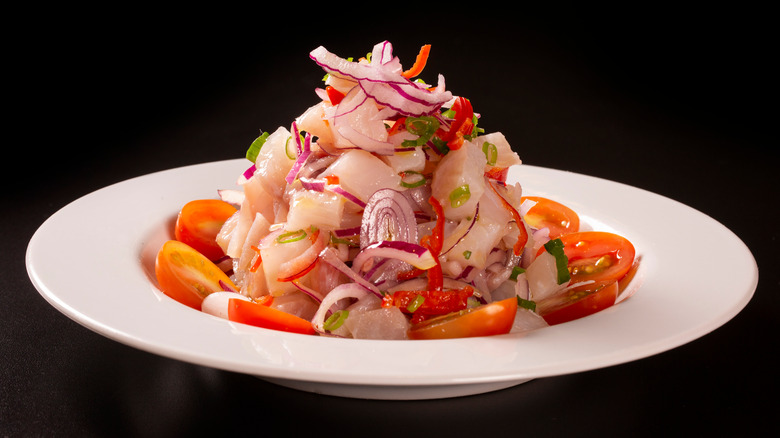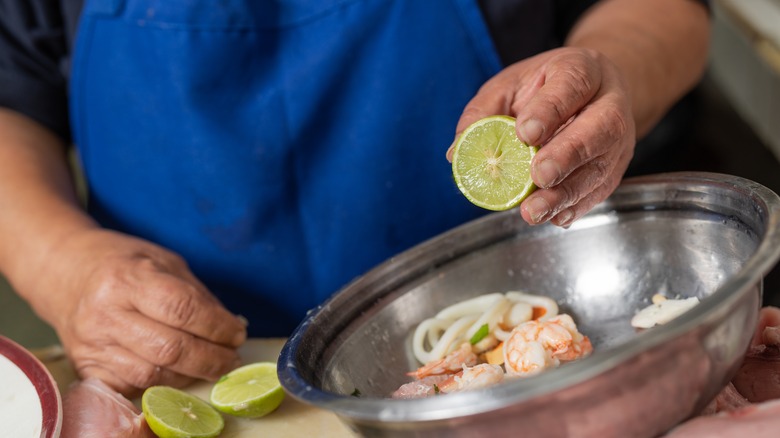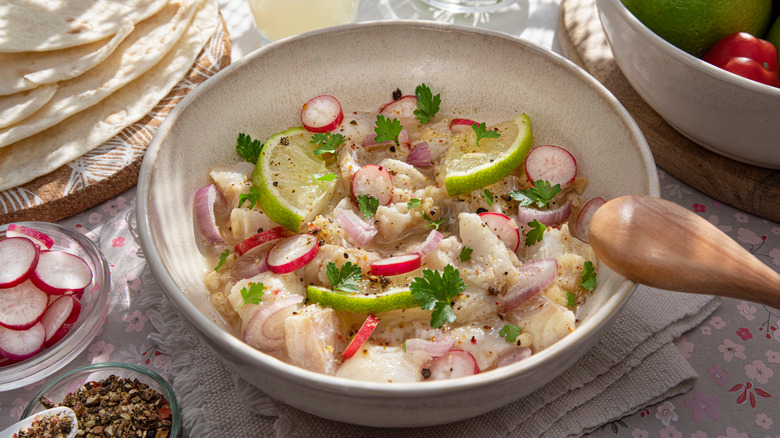The Science Behind How Ceviche Is 'Cooked'
Many popular dishes around the world make use of raw fish, from tartare to aguachile to poke. A lot of people would add ceviche to that list, but it doesn't quite belong there, since it has actually been cooked ... well, sort of. Ceviche exists in a unique interzone between raw and cooked, one that we don't have a word for. We'll settle for using the term 'cooked' with emphasis on the quotation marks, as the process comes not from heat but rather from an acidic marinade.
Ceviche is made from raw seafood marinated in citrus juice, but that's about the only strict rule regarding it. The dish is highly versatile, so you can make it with a number of different fish or shellfish, experiment with different marinades, and add just about any additional ingredients you like, with chili peppers and onions being the most traditional. Speaking of tradition, we need to give proper credit for the invention of ceviche, which originated in Peru, possibly as far back as 2,000 years ago. Today, it is considered the country's national dish, and the coastal capital of Lima boasts over 2,000 restaurants dedicated to its preparation, called cevicherias. The dish has also been popularized across the globe, with its customizable nature and simple preparation welcoming a broad array of ingredients.
Ceviche is 'cooked' with acid rather than heat
It's not quite right to say ceviche is cooked since cooking entails heat. However, the acidic marinade used for ceviche causes the seafood to undergo similar chemical changes as cooking it would. Both heat and acid cause the strands of protein within the fish's flesh to denature, meaning that their structures change, in turn, altering the color and texture of the meat. This happens because high temperatures and low pH levels break the hydrogen bonds within protein molecules, causing the long strands to unravel. More specifically, the acid targets a type of protein called myosin, causing the molecules to form new bonds and thicken. In the case of ceviche, the fish changes from silky and nearly diaphanous to firm and opaque. This process occurs more mildly when using acid rather than heat, so the fish stays tender, whereas cooking might dry it out.
Anytime you're eating raw food, there is bound to be some concern about bacteria. Raw fish is generally considered safe, an opinion proven time and time again by sushi bars, poke bowl stands, and the like. However, it is essential that you buy fresh seafood for ceviche, ideally using it right away. The marinade might have antimicrobial properties, but it's still essentially a raw product. Therefore, it's wisest to treat ceviche with more care than, say, oven-baked salmon fillets.
The marination time is critical for ceviche
Just as cooking times are essential to achieve the right combination of flavor and texture in meat, the time that you marinate ceviche will have a tremendous impact on your dining experience. If you let the fish marinate too long, the acid will break down all of the connective tissue, making the meat tough. Of course, failing to marinate it for long enough will leave you with plain old raw fish. Ideal marination seems to be somewhere between 10 and 25 minutes, and since ceviche is served in its own marinade, this is the window in which you should eat it. For a classic Peruvian experience, save what marinade remains once you've eaten all the fish and drink it straight from a shot glass. This residual liquid is known as leche de tigre (tiger's milk), and it is popularly used as a hangover cure.
On a final note, choosing the right type of seafood is vital for preparing ceviche. You have a lot of leeway here, as the ceviche preparation method is very versatile; however, there are certain parameters to consider. Firstly, you want to make sure you use saltwater seafood, not freshwater fish such as trout. Secondly, you want to avoid fish that are very oily such as bluefish and mackerel. Other than that, there are literally plenty of other fish and shellfish in the sea. The most classic choice would be a firm white fish such as bass or flounder.


